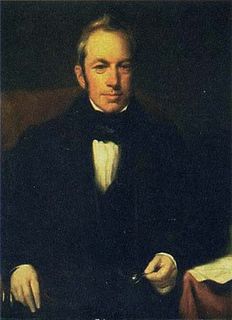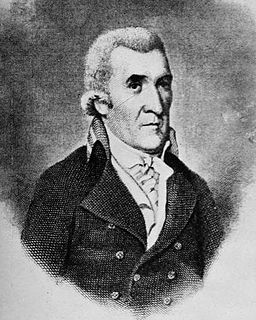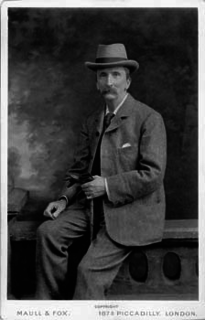
Lichenology is the branch of mycology that studies the lichens, symbiotic organisms made up of an intimate symbiotic association of a microscopic alga with a filamentous fungus.

Robert Brown was a Scottish botanist and paleobotanist who made important contributions to botany largely through his pioneering use of the microscope. His contributions include one of the earliest detailed descriptions of the cell nucleus and cytoplasmic streaming; the observation of Brownian motion; early work on plant pollination and fertilisation, including being the first to recognise the fundamental difference between gymnosperms and angiosperms; and some of the earliest studies in palynology. He also made numerous contributions to plant taxonomy, notably erecting a number of plant families that are still accepted today; and numerous Australian plant genera and species, the fruit of his exploration of that continent with Matthew Flinders.

Sir John Forbes FRCP FRS was a distinguished Scottish physician, famous for his translation of the classic French medical text De L'Auscultation Mediate by René Laennec, the inventor of the stethoscope. He was physician to Queen Victoria 1841–61.
Henry Brougham Guppy was a British surgeon, geologist, botanist and photographer. He was awarded the Linnean Medal in 1917.

Dr William Wright (1735–1819) was a Scottish physician, botanist and slave owner. In 1783 he was a joint founder of the Royal Society of Edinburgh.

William Carmichael M'Intosh LLD was a Scottish physician and marine zoologist. He served as president of the Ray Society, as vice-president of the Royal Society of Edinburgh (1927–30), and was awarded the Neill Prize (1865-8).

William West, FLS was an English pharmacist, botanist, microscopist and writer, particularly noted for his studies of freshwater algae. His sons, both botanists, were William West Jr with whom he did fieldwork, and George Stephen West with whom West co-wrote botanical publications for more than 20 years.

David Douglas Cunningham was a Scottish doctor and researcher who worked extensively in India on various aspects of public health and medicine. He studied the spread of bacteria and the spores of fungi through the air and conducted research on cholera. In his spare time he also studied the local plants and animals.

Thomas Taylor (1786–1848) was an Irish botanist, bryologist, and mycologist.
William Baird was a Scottish physician and zoologist best known for his 1850 work, The Natural History of the British Entomostraca.
John Scott FLS was a Scottish botanist and gardener.
William Borrer was an English botanist noted for his extensive and accurate knowledge of the plants of the British Islands.

John Vaughan Thompson FLS was a British military surgeon, marine biologist, zoologist, botanist, and published naturalist.
Benjamin Carrington FRSE FLS MRCS was a leading British botanist and taxonomist in the late 19th century. He was a specialist in bryophytes, cryptogams, fungi and lichens, and wrote extensively on these subjects.
Sir David James Hamilton Dickson OSV FRSE FRCSE FRCPE FLS (1780–1850) was a Scottish naval surgeon, medical author and amateur botanist, serving during the Napoleonic Wars and War of 1812 between Britain and the United States.
James Robinson Scott FRSE FLS PRMS was an 18th/19th century Scottish naval surgeon and amateur botanist. He served as Senior President of the Royal Medical Society 1818/19.

John Lindsay Stewart (1831–1873) was a 19th-century Scottish botanist remembered for his conservation of Indian forests.
Robert James Nicholl Streeten was a British physician and medical editor and secretary of the Provincial Medical and Surgical Association.
James Stirton was a Scottish physician and one of Scotland's leading experts on cryptogamic botany. His investigations in bryology and lichenology earned him a world-wide reputation.

David John Galloway, FRSNZ was a biochemist, botanist, and lichenologist.











